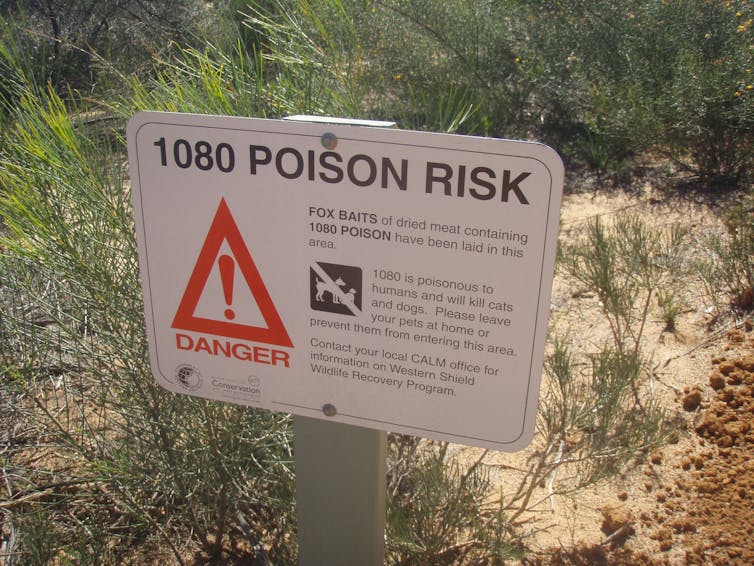
Use of sodium fluoroacetate poison baits – commonly known as 1080 – to kill unwanted animals is widespread in Australia. But it occurs largely out of sight and out of mind. We may see signs warning the baits have been laid, but we rarely see the consequences.
When someone else’s dog dies after eating 1080 poison bait, news reports briefly rattle our sense of security. But the people concerned can be left distressed and traumatised.
In our new research, we interviewed seven people about their dog’s death from 1080 poisoning. We identified common themes and how these contributed to changed attitudes toward lethal control methods. This is the first qualitative study to give voice to people whose dogs have been unintentionally harmed by 1080.
Australia is only one of a handful of countries that allow the use of 1080 baits. We hope our results will inform decision-making by the government agencies, farmers and conservation organisations that use the poison.

Read more: How Australia made poisoning animals normal
Lethal control by 1080
Since the 1950s, Australian governments, private contractors and property owners have used 1080 poison baits to kill “pest” animals such as foxes, rabbits, cats, pigs and wild dogs, including dingoes.
Depending on the target species, their food of choice is laced with poison (carrots for rabbits, grain for pigs, meat for foxes, wild dogs and dingoes).
The “metabolic poison” disrupts the energy powerhouse of the body’s cells (the mitochondria). The delay between ingestion and signs of toxicity can be anywhere between 30 minutes and 20 hours. Initial signs include vomiting, anxiety and shaking. But that’s only the beginning of what can be a long, painful and violent death.
Native Australian animals vary in their tolerance to the poison. That’s because it is derived from a naturally occurring compound (potassium fluoroacetate) found in several native Australian plants. Though, in parts of the country, it is used to kill native animals too, such as wallabies and possums.
But companion animals such as dogs can also consume the baits. Their suffering, often witnessed by owners, provides important insights into what wild animals experience when poisoned.
Our research aimed to understand the impact the death of a companion dog from 1080 poisoning has on people and their relationships with other animals.
A strong sense of responsibility
Our results reveal how a brief encounter with 1080 had traumatic and life-altering consequences.
The participants loved their dogs and considered them family. They felt responsible for providing a happy, healthy life that included walking or running in nature. It was usually during these walks in familiar places that encounters with 1080 occurred.
Some people didn’t know about 1080, while others were very aware and took precautions like avoiding local areas known to be baited.
Several participants were shocked by how quickly their dogs ate a bait, after briefly snuffling at the ground or disappearing out of sight for just a moment. They struggled with the fact that a short lapse in their attention was all it took to lose their dog forever.
Others didn’t realise what had happened for hours, until the onset of symptoms or death.
The horror: ‘just running away from pain’
People described the death of their “loved one” from 1080 baiting as one of the most horrific experiences of their lives. Symptoms of 1080 poisoning included uncontrollable vomiting, defecating, urinating, frenzied running, barking, “screaming”, convulsions, confusion, fear, coma and finally, death.
The dogs seemed terrified and their guardians felt completely powerless in the face of extended suffering. As one participant told us:
He was just running away from pain […] He was running that fast and he obviously had no control over what his body was doing, he just hit the fence at full speed, it dropped him to the ground and he’s on the ground snarling and biting and whatnot, at himself, at me, anyone who tried to get near.
Those who weren’t present when their dogs died felt guilty for not supporting their dog through their pain.
Traumatic grief: ‘I can’t get it out of my mind’
Any loss of a companion animal can cause feelings of grief. However, traumatic loss of a companion in such an unexpected and violent way is better captured by the concept of traumatic grief. One participant vividly recalled their dog’s death:
I can’t get it out of my mind […] her face like that and, you know, she wasn’t vicious at all […] it was so absolutely heartbreaking. I can’t even […] heartbreaking is not the right word for it. No, I need a more intense word than heartbreaking, just to see someone that you love go through that and know that they suffered every second until they died.
We found the experience with 1080 changed people’s relationships and attitudes to dogs, wildlife, nature and government authorities.
They reported being anxious and hypervigilant for signs of 1080 poisoning in other dogs. Some could no longer visit locations where the poisoning occurred.

Many participants wanted to save other animals from suffering like their dog did. All participants believed no animal should be exposed to 1080 poison, regardless of species or wild status. Some went on to actively advocate against the use of 1080 bait.
The role of authorities
For several participants, their suffering was amplified by a perceived lack of accountability from authorities. They believed officials dismissed and belittled their experience of losing a dog to 1080 poisoning.
Participants viewed 1080 baiting as a deliberate choice that led to their dog’s suffering and death. They were angry that anyone would knowingly choose such a violent management approach. In the words of one participant:
What an inhumane thing to do to any living creature. […] I am just angry that this is happening in Australia, I really am. We are such a progressive country. It’s banned in so many parts of the world. And Australia, of all places, is still using it. […] It’s just not Australian to see a wild animal, never mind a dog that you love, die like that.
There have been public calls to ban 1080. Indeed, we believe a more compassionate approach is needed: one that values the interests and agency of both wild and companion animals. It is time for Australia to reconsider its use of 1080.
We would like to acknowledge the work of our colleague Melissa Zeven who led this research. We appreciate their efforts in conducting participant interviews and analysing such emotionally difficult stories.
Dr Adam Cardilini is a member of the Animal Justice Party and volunteers in it's policy working group. He is also a fellow at PAN Works (https://panworks.io/), an international ethics think tank dedicated to the wellbeing of animals. The work in this article was partly supported by funding from Deakin University.
Dr Alexa Hayley is a member of the Animal Justice Party and Animals Australia, and is currently employed by Geelong Animal Welfare Society and Deakin University, School of Psychology.
Dr Bill Borrie has previously received funding from the US Forest Service and is currently a Fellow with PAN Works.
This article was originally published on The Conversation. Read the original article.







